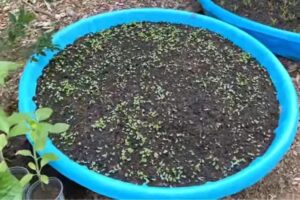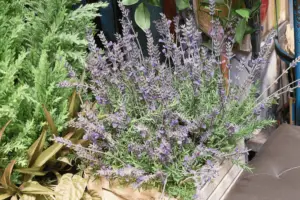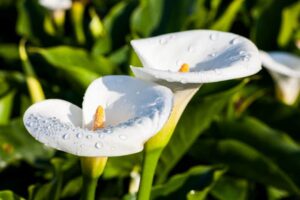
We often come across the question, “Can you plant tomatoes in a kiddie pool?” The direct answer is yes.
You can plant tomatoes in a kiddie pool. It provides a suitable container for growing tomatoes, offers good drainage, and allows for efficient water retention. However, you must ensure proper soil quality, provide adequate support for the plants, and monitor water levels regularly.
Moreover, planting tomatoes in a kiddie pool is a unique and creative way to grow these delicious fruits in a limited space. It offers several advantages, such as easy access, better water retention, and portability. Let’s explore the process of planting tomatoes in a kiddie pool, including step-by-step instructions, advantages, disadvantages, and other essential information.
Selecting the Right Tomato Varieties
Selecting the right tomato varieties for planting in a kiddie pool is the first crucial step that ensures successful growth and a fruitful harvest. Here are some factors to consider when choosing tomato varieties for your kiddie pool garden:
1. Determinate vs. Indeterminate: Determine whether you prefer determinate or indeterminate tomato varieties. Determinate varieties tend to grow to a compact size and produce their fruit over a relatively short period. Indeterminate varieties, on the other hand, continue to grow and produce fruit throughout the growing season. Indeterminate varieties may require more support and pruning to manage their vigorous growth.
2. Size: Consider the size of the tomato plants and the space available in your kiddie pool. Some tomato varieties are naturally compact, making them well-suited for container gardening. Look for varieties labeled as “patio,” “dwarf,” or “bush” for smaller plants that fit well in confined spaces.
3. Container-Friendly Varieties: Certain tomato varieties are specifically bred for container gardening and perform well in limited spaces. Look for varieties described as “container” or “patio” tomatoes. These varieties are typically more compact, have smaller root systems, and adapt well to growing in containers.
4. Disease Resistance: Check for disease-resistant varieties to minimize the risk of common tomato diseases such as blight or wilt. Disease-resistant varieties are bred to have increased resistance to specific diseases, making them more likely to thrive even in challenging conditions.
5. Flavor and Use: Consider your personal preferences when it comes to tomato flavor and intended use. Some varieties are known for their sweetness, while others have a more acidic or tangy taste. Additionally, determine whether you want tomatoes primarily for fresh eating, canning, or cooking purposes.
6. Ripening Time: Look for tomato varieties with varying ripening times to ensure a more extended harvest season. Selecting early-maturing, mid-season, and late-maturing varieties can help stagger the ripening of your tomatoes and extend the period of fresh, ripe fruits.
7. Climate Suitability: Take into account your local climate and growing conditions. Some tomato varieties are better suited for cooler climates, while others thrive in hot and humid environments. Choose varieties that are known to perform well in your specific region.
8. Heirloom vs. Hybrid: Decide whether you prefer heirloom or hybrid tomato varieties. Heirloom tomatoes are open-pollinated varieties that have been passed down through generations and are known for their unique flavors. Hybrid tomatoes, on the other hand, are bred by crossing two different varieties and often possess desirable traits such as disease resistance, higher yields, or improved vigor.
Consider a combination of these factors when selecting tomato varieties for your kiddie pool garden. It’s also a good idea to consult with local garden centers, experienced gardeners, or agricultural extension services for recommendations on varieties that have proven successful in your area.
Best Kiddie Pool Size for Tomato Planting
When it comes to selecting a kiddie pool for planting tomatoes, the size of the pool plays a second crucial role in providing adequate space for the plants to grow and develop a healthy root system. Have a look at some considerations for choosing the best kiddie pool size for tomato planting:
- Depth: Tomato plants require a sufficient depth of soil to accommodate their extensive root systems. Opt for a kiddie pool with a depth of at least 12 to 18 inches (30 to 45 cm). This depth allows the roots to spread out and access moisture and nutrients effectively.
- Diameter: The diameter or width of the kiddie pool determines how many tomato plants you can grow. While the number of plants may vary based on personal preference and available space, a pool with a diameter of 3 to 4 feet (90 to 120 cm) is generally recommended. This size provides ample room for multiple tomato plants while still allowing for proper air circulation and plant growth.
- Capacity: Consider the capacity or volume of the kiddie pool in terms of soil required for planting tomatoes. A pool with a capacity of 30 to 50 gallons (113 to 189 liters) is typically sufficient for growing two to four tomato plants. This capacity allows for enough soil to support root development and provides ample space for the plants to grow and spread their branches.
- Space Constraints: Assess the available space in your garden, patio, or balcony before choosing a kiddie pool size. If you have limited space, opt for a smaller-sized kiddie pool that fits comfortably in your designated gardening area. Compact pools with a diameter of 2 to 3 feet (60 to 90 cm) can still accommodate one to two tomato plants and are suitable for smaller spaces.
- Mobility: Consider the ease of moving the kiddie pool if portability is a priority. Smaller-sized pools are generally lighter and more manageable to transport, allowing you to relocate your tomato plants as needed to optimize sunlight exposure or protect them from adverse weather conditions.
Note:
Remember to ensure that the kiddie pool you choose is made of sturdy and durable materials, capable of withstanding the weight of the soil, water, and growing tomato plants. Additionally, adequate drainage holes are essential to prevent waterlogging and ensure proper soil moisture levels.
How to Plant Tomatoes In A Kiddie Pool (Step-by-Step Process)

Now you have chosen the tomato varieties and taken your desired kiddie pool. Let’s move to the planning process.
Step 1: Selecting the Kiddie Pool:
Hopefully, you have chosen a sturdy and durable kiddie pool that is large enough to accommodate the tomato plants. Next, consider the number of plants you want to grow and the available space in your garden or patio.
Step 2: Preparing the Kiddie Pool:
Clean the kiddie pool thoroughly with mild soap and water to remove any dirt or debris. Rinse it well and ensure it is completely dry before proceeding.
Step 3: Choosing the Right Soil:
Tomatoes thrive in well-draining soil with a pH level between 6.0 and 6.8. Use a high-quality potting mix or create your own by combining equal parts of compost, perlite, and peat moss. Avoid using garden soil, as it may contain pests, diseases, or weed seeds.
Step 4: Filling the Kiddie Pool:
Fill the kiddie pool with the prepared soil, leaving a few inches of space at the top. Ensure the soil is evenly distributed and not compacted.
Step 5: Planting the Tomato Seedlings:
Dig holes in the soil, spaced about 2 feet apart, to accommodate the tomato seedlings. Gently remove the seedlings from their containers and place them in the holes. Backfill the holes with soil, firming it gently around the base of the plants.
Step 6: Providing Support:
Tomato plants require support to grow upright and prevent them from bending or breaking under the weight of the fruit. Install stakes or cages around each tomato plant, securing them firmly into the soil.
Step 7: Watering:
Water the tomato plants thoroughly after planting to settle the soil around the roots. Maintain consistent moisture levels throughout the growing season, ensuring the soil remains moist but not waterlogged. Regularly check the moisture level by sticking your finger into the soil. If it feels dry, water the plants deeply.
Step 8: Fertilizing:
Apply a balanced, slow-release fertilizer according to the package instructions or use organic alternatives such as compost or well-rotted manure. Feed the tomato plants every two to three weeks during the growing season to provide them with essential nutrients.
Step 9: Pruning and Maintenance:
Regularly monitor the tomato plants for any signs of pests, diseases, or nutrient deficiencies. Prune the plants to remove suckers (extra stems that grow in the leaf axils) and improve airflow around the plants. This helps prevent disease and encourages better fruit production.
Advantages of Planting Tomatoes in a Kiddie Pool:
- Accessibility: The raised height of the kiddie pool makes it easier to tend to the tomato plants, reducing strain on the back and knees.
- Water Retention: The deep design of the kiddie pool allows for efficient water retention, reducing the frequency of watering.
- Portability: Kiddie pools are lightweight and portable, allowing you to move your tomato plants to different areas of your garden or patio if needed.
Disadvantages of Planting Tomatoes in a Kiddie Pool:
- Limited Growing Space: The size of the kiddie pool may limit the number of tomato plants you can grow compared to planting them in the ground or larger containers.
- Soil Quality: The soil in the kiddie pool may require more amendments and regular fertilization to ensure optimal plant growth and fruit production.
- Drainage: While kiddie pools generally have good drainage, it’s essential to monitor water levels to prevent overwatering, which can lead to root rot or other water-related issues.
Troubleshooting Potential Problems with Tomato Plants in a Kiddie Pool:
1. Overwatering or Underwatering:
- Check soil moisture regularly and water when the soil feels dry up to the first knuckle.
- Avoid overwatering, which can lead to root rot, and underwatering, which can cause nutrient deficiencies.
- Adjust your watering schedule to maintain consistently moist but not waterlogged soil.
2. Nutrient Deficiencies:
- Monitor the appearance of tomato leaves for signs of nutrient deficiencies, such as yellowing or browning.
- Adjust fertilization practices to provide the necessary nutrients.
- Use a balanced fertilizer or organic alternatives like compost or well-rotted manure.
3. Pests:
- Keep an eye out for common tomato pests like aphids, caterpillars, or tomato hornworms.
- Use organic pest control methods or insecticidal soaps to manage infestations.
- Inspect plants regularly and remove any pests by hand.
4. Diseases:
- Watch for signs of common tomato diseases like blight, blossom end rot, or fungal infections.
- Remove infected leaves or fruits promptly to prevent the spread of disease.
- Ensure good air circulation around the plants and avoid overhead watering.
5. Lack of Support:
- As tomato plants grow, provide support by tying or training the main stem to stakes or cages.
- Prune suckers that develop in the leaf axils to maintain an upright growth habit and prevent sprawling.
6. Extreme Temperatures:
- Protect tomato plants from extreme temperatures, such as frost or heatwaves.
- Move the kiddie pool to a sheltered area or cover plants with protective materials as needed.
Pollination Issues:
Note:
If growing tomatoes indoors or in an area with limited pollinators, gently shake the plants to aid in pollination.
Consider hand-pollinating by using a small brush to transfer pollen between flowers.
What type of soil should I use when planting tomatoes in a kiddie pool?
Answer: It is best to use a potting mix specifically formulated for container gardening when planting tomatoes in a kiddie pool.
How much sunlight do tomatoes need when planted in a kiddie pool?
Answer: Tomatoes need at least 6-8 hours of direct sunlight each day in order to produce fruit. If possible, position the kiddie pool in an area that receives lots of sunlight.
Conclusion
Planting tomatoes in a kiddie pool is a fun and innovative way to grow these popular fruits. By following the step-by-step process outlined above, you can create a thriving tomato garden in a limited space. Consider the advantages, disadvantages, and maintenance requirements before starting your own kiddie pool tomato garden. Happy gardening!






